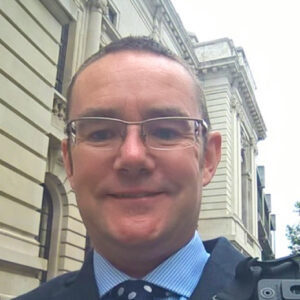About the author: Pete Dalton MSyl, is a UK-based international major events and protective security consultant. As a former specialist UK Police Senior Officer, he was the Head of the Department responsible for Protective Security. Pete maintained a range of specialist command accreditations including, Specialist Tactical Firearms Commander and Counter Terrorism Security Coordinator he managed, planned and commanded major operations and events throughout his service.
He is now engaged in a diverse range of key projects supporting major international sporting and crowded space events, consulting for several Law Enforcement Agencies, crowded space consultancies and academic institutions. He delivers specialist advice and training in all aspects of planning, event management and incident command. Pete has delivered the Interpol- International Safety & Security Training Programme to police commanders from 60 countries.
Our thoughts go out to the victims and families of the tragic event that happened this past weekend in Itaewon, Seoul. Young persons, seeking to socialise in the popular nightlife district for Halloween found themselves inadvertently caught in a crowd crush, which has led to over 150 fatalities and high numbers of injuries.

This blog will seek to summarise key challenges faced and to support event management principles in identifying key components in developing event management plans.
A full review will follow; I hope that this includes an international dimension and independent element. It is interesting to see the local Police Chief already recognising that failings were made. For emergency services, the constitution and legal framework will outline the primary and secondary responsibilities of Police, Fire and Emergency Medical Services. Interestingly, in the UK, USA and most of Europe the emergency services do not have primary responsibility for crowd management, only crowd control.
Indeed, in most international events the private sector and professional events management have the primary responsibility and greater capability for crowd management than the police. This has evolved through the professionalisation of the event management sector.
Early indications outline that this was not a planned event, as such, an event organiser and integrated planning team was not established. Further commentary indicates a traditional and highly popular Halloween gathering in the popular bars and clubs of Itaewon, as part of the Cities Night-time Economy.
What went wrong?
The lack of integrated planning and an event management team / organiser creates risks to safety, security and service. The lack of an established emergency services Incident Command Structure (ICS) hinders the emergency response. This is due to a lack of strategic approach, and inability to immediately collocate, communicate and coordinate resources, with shared situational awareness and joint understanding of the risk. That said, the deployment of 1700 emergency responders speak to the capacity of Seoul, it is unlikely that most cities could match these numbers as part of an immediate deployment to a spontaneous mass casualty incident.

Whilst the international media commentary is expanding, there are some key (sadly all too familiar) themes emerging for crowd management professionals. The proximate cause of the fatalities and serious injuries resulted from excessive crowd densities in the narrow alleyway (4m by 40 m= 160 m2). This alley had a steep downhill 20% gradient with no lateral escape routes. Poor lighting and ambient noise would have contributed towards a confusing environment.
Throughput and flow through the alley appear to have been compromised by increases in crowds. Some, unconfirmed reports indicate a rumour that a celebrity was within a bar in the area. Cross and counter flows from at least three directions converged in this vicinity, the largest source being the main transport node, the metro station. The throughput at the metro is reported at >80,000, three times for average.
As static and dynamic densities increased beyond 6 ppm2, crowd turbulence occurred, this is evident in the videos, such turbulence is widely understood by scientists and results from Newtons Laws. The turbulence causes involuntary and powerful movements with forces that lead to compressive asphyxia (the cause of death). This was not a stampede; indeed, a stampede is not possible in these densities. Prof Keith Still has been commenting extensively in the media, Keith has vast experience in this area. His website provides key reference for professionals.
A Legal Review Taking Place
Legal reviews normally focus on the competence of key personnel and their actions, inactions, planning and decision making to establish negligence. Distal causes (planning and assurance) and proximate causes (operational management & response) will be considered against ‘reasonably foreseeable’ assessments of the key threats.
It has been reported that following COVID-19 and strict mitigation in South Korea, it was well known that this would be a significant social gathering, linked to a key festivity event (Halloween), popular in culture with young people. The psychosocial needs to socialise and come together in crowded spaces is a powerful driver.
It is likely that the review will focus on known and predictable crowd profiling, space utilisation and the wider area of Itaewon’s night-time economy. If the bars and clubs pay business rates to the local authority, it may be possible to conclude that an assessment and planning should have been undertaken by a competent body, such as the local authority or municipality. The 137 police officers initially deployed were not deployed in a crowd management / control posture, but to deliver primary policing functions (prevention of crime, maintenance of order etc).
What can be done in the future?
So, whilst awaiting the findings of the review and with reflection to other events, what can we as event professionals do to manage, minimise or mitigate risks to safety, security & service? I was interviewed by the Washington Post this week as part of their review into the incident, key issues discussed included:
- The need to conduct event analysis and crowd profiling
- Identifying planned events and understanding how cultural festivities can lead to spontaneous gatherings in an area
- Understanding the environment and suitability of event locations
- Considering how recognised crowd risk management processes such as DIMICE, RAMP, Congestion mapping, Crowd Dynamics and decision controls
- Establishing an event management team that is interoperable with emergency services Incident Command Systems
- Employing and deploying competent managers, specialists and crowd management teams
- Monitoring and managing crowds and having the ability to manage free flow, constraint and control measures
- Ensuring effective planning, assurance, deployment and review
- Establishing multi-nodal communications with spectators
- Considering how people, processes and technology can be deployed to support events
Professional reviews, discussions and information sharing will prove valuable in managing such risks. As always, there is a need to integrate event planning with emergency management. Crowd dynamics, crowd science and the application of crowd management must integrate with security and service. Event professionals should be inquisitive in learning from such case studies, adopting a spirit of detailed analysis and without seeking to apportion blame.
Emerging technology can and must support planning, assurance, delivery and review. OnePlan enables the capability to support all aspects of event delivery, when adopted as an integrated planning platform it can enhance collaboration, enable a single source of truth and underpin all aspects of crowd management.
As a consultant in protective security and crowded space management, I use OnePlan extensively in all my projects. I use OnePlan to reverse engineer and reconstruct international incidents, this provides valuable learning and a highly visual representation of key facts. Part of my review into this and other recent cases will include active analysis of the events, supported by the extensive crowd management tools for areas, flow and densities. By following media, reviewing academic research and watching the vast array of social media, it is possible to gain a full appreciation of the timeline to tragedy in this and other cases.














